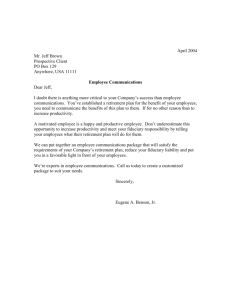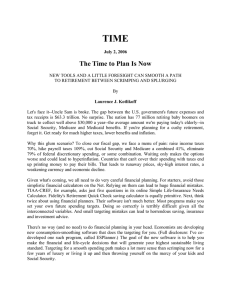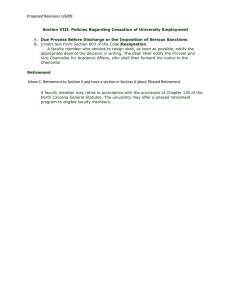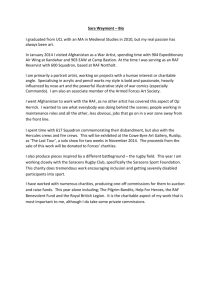aft
advertisement
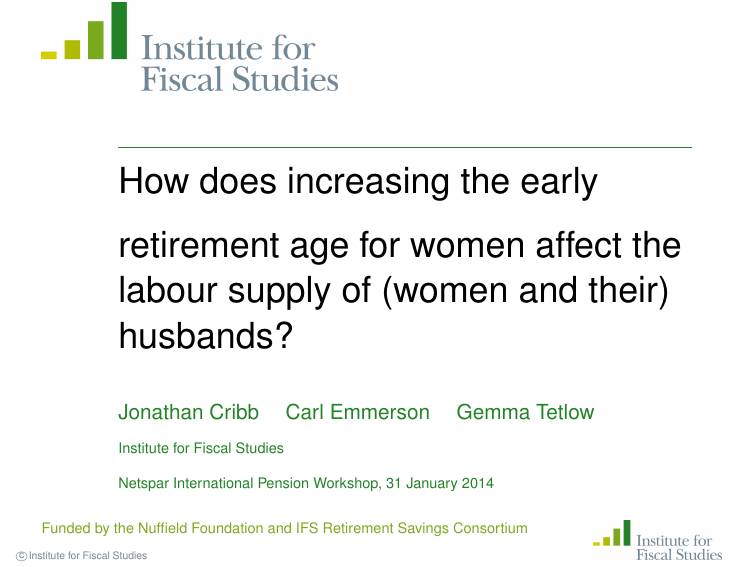
raf t How does increasing the early retirement age for women affect the labour supply of (women and their) husbands? Jonathan Cribb Carl Emmerson Gemma Tetlow Institute for Fiscal Studies Netspar International Pension Workshop, 31 January 2014 Funded by the Nuffield Foundation and IFS Retirement Savings Consortium c Institute for Fiscal Studies raf t Overview Reforms to retirement incentives for one individual could have spillover effects on their partner If there are interdependencies in labour supply within couples Could amplify or dampen overall effect of the policy Use evidence from recent reform to early retirement age for women in the UK Early retirement age for women rose from 60 to 61 (occurred between 2010 and 2012) What was the effect of this reform on husbands’ labour supply? Estimate the effect on women’s labour supply Estimate knock-on effect on husbands’ labour supply c Institute for Fiscal Studies raf t Outline 1 Existing literature 2 Policy background 3 Theory 4 Data and estimation strategy 5 Results Women’s labour supply Husbands’ labour supply 6 Conclusion c Institute for Fiscal Studies raf t Literature Individuals’ labour supply often thought to be complementary to spouse’s employment or earnings Schirle (2008); Goux, Maurin and Petrongolo (2014); Gelber (forthcoming) Other papers find substitutability between spouses’ labour supply, often in reaction to job loss Lundberg (1985); Cullen and Gruber (2000) One form of interdependency of labour supply is joint retirement Some papers develop structural models of joint retirement Gustman and Steinmeier (2000); Maestas (2001); Gustman and Steinmeier (2004); Casanova (2010) Other papers identify joint retirement using exogenous variation in one partner’s labour supply Baker (2002); Coile (2004); Banks, Blundell and Casanova (2010); Stancanelli (2013) c Institute for Fiscal Studies raf t Increasing the early retirement age for women Legislation passed in 1995 increased the early retirement age (known in UK as "state pension age") for women in the UK from 60 to 65 Due to be phased in between 2010 and 2020 Motivated by a requirement to equalise the treatment of men and women More recent legislation has accelerated and extended the increase Early retirement age for men is 65 ERA for men and women will increase to 66 between 2018 and 2020 c Institute for Fiscal Studies raf t Increases in the early retirement age for women Source: Figure A.1 of Cribb, Emmerson and Tetlow (2013). c Institute for Fiscal Studies raf t Increases in the early retirement age for women Source: Figure A.1 of Cribb, Emmerson and Tetlow (2013). c Institute for Fiscal Studies raf t Increases in the early retirement age for women Source: Figure A.1 of Cribb, Emmerson and Tetlow (2013). c Institute for Fiscal Studies raf t What happens at the early retirement age? Earliest age at which one can draw a state pension ERA is the only focal age in the UK state pension system State pension comprises: Flat-rate component: basic state pension, paid to everyone who has 30 years’ contributions (e6,900 per year) Earnings-related component: state earnings-related pension scheme (now state second pension) (up to c. e10,300 p.a.) No earnings test for receipt of state pension income Claiming and leaving paid work separate decisions (in theory) Tax and benefit system also changes at early retirement age Pensioners eligible for more generous (income and health tested) benefits with less conditionality Employee payroll taxes eliminated (reduce marginal rate by up to 12 percentage points) c Institute for Fiscal Studies raf t Why might increasing women’s early retirement age affect their husbands’ labour force participation? Couples deciding on labour supply decisions together, rather than independently Husbands of affected women may increase their labour supply as alternative margin for household to respond to wealth loss If there are complementarities in leisure, husband may delay retirement when wife delays hers c Institute for Fiscal Studies raf t Data UK Labour Force Survey data Quarterly household level survey with around 100,000 individuals per quarter Allows us to link spouses together Each household included in the survey for up to 5 consecutive quarters Observe month and year of birth: allows calculation of early retirement age Use data from one year prior to rise in the ERA (2009Q2) up to 2012Q2 Use one cohort of women (and their husbands) unaffected by the reform and three affected cohorts (1949–1952) Restrict attention to husbands aged 55–69 Sample sizes of 30,297 women and 18,776 husbands c Institute for Fiscal Studies raf t Female economic activity prior to ERA increase Notes: Averages over the period 2003Q1 to 2010Q1. Source: Figure 2.1 of Cribb, Emmerson and Tetlow (2013). c Institute for Fiscal Studies raf t Female economic activity prior to ERA increase Notes: Averages over the period 2003Q1 to 2010Q1. Source: Figure 2.1 of Cribb, Emmerson and Tetlow (2013). c Institute for Fiscal Studies raf t Female economic activity prior to ERA increase Notes: Averages over the period 2003Q1 to 2010Q1. Source: Figure 2.1 of Cribb, Emmerson and Tetlow (2013). c Institute for Fiscal Studies raf t Employment of 60 year old women has risen since 2010 Source: Figure 2.2 c Institute for Fiscal Studies of Cribb, Emmerson and Tetlow (2013). raf t Employment of 60 year old women has risen since 2010 Source: Figure 2.2 of Cribb, Emmerson and Tetlow (2013). c Institute for Fiscal Studies raf t Employment of 60 year old women has risen since 2010 Source: Figure 2.2 of Cribb, Emmerson and Tetlow (2013). c Institute for Fiscal Studies raf t Employment of 60 year old women has risen since 2010 Source: Figure 2.2 of Cribb, Emmerson and Tetlow (2013). c Institute for Fiscal Studies raf t Empirical methodology (Women) Difference-in-differences methodology to identify the effect of raising the early retirement age on women’s economic activity A yict = αTict + γt + λc + ∑ δa [ageict = a] + Xict0 β + eict a=1 y is the outcome of interest (e.g. being in work) T indicates being under the early retirement age Identification of treatment effect assumes: age- and cohort-constant time fixed effects (γt ) – quarters time- and age-constant cohort fixed effects (λc ) – years cohort- and time-constant age fixed effects (δa ) – quarters Also control for education, ethnicity, housing tenure, marital status, region, husband’s age, husband’s education (X ) c Institute for Fiscal Studies (1) raf t Effect of increase in ERA on women’s employment Table: Effect of increasing the early retirement age from 60 to 61 on employment rate of women Effect of being under ERA Std. error Sample size +0.073*** 0.019 30,297 +0.126*** +0.054** 0.034 0.023 8,818 21,479 Estimated by Probit All women Subgroups estimated by OLS Single women Women with a partner Notes: Standard errors are clustered at the individual level and estimated by bootstrapping with 1000 replications. c Institute for Fiscal Studies raf t Effect of increase in ERA on women’s employment Increase in the early retirement age explains almost all excess retirements that occurred at age 60 prior to the rise in ERA We find no variation in the effect by housing tenure (indicator of credit constraints) Those women who face the largest fall in their participation tax rate when the ERA rises do not have the largest response Including cohort fixed effects controls for much of the wealth loss caused by increasing the ERA Suggests that a social norm is an important reason for response to the increase in the ERA c Institute for Fiscal Studies raf t Husbands’ employment prior to increase in ERA for women Notes: Averages c Institute for Fiscal Studies over the period 2003Q1 to 2010Q1. raf t Men were more likely to leave work when wife turns 60 Notes: Averages over the period 2003Q1 to 2010Q1. Source: Figure 2.3 of Cribb, Emmerson and Tetlow (2013) c Institute for Fiscal Studies raf t Empirical methodology (Men) Estimate equivalent model to women in order to estimate effect on husbands’ labour supply W yict = αTict + γt + λc + A ∑ h i W 0 δa ageict = a + Xict β + eict (2) a=1 T W is an indicator of wife being aged under early retirement age Other controls are the same as included in the model of women’s behaviour Including controls for husband’s age (quadratic), indicators for husband being over 65 and being over female early retirement age c Institute for Fiscal Studies raf t Effect of increasing the early retirement age from 60 to 61 on husbands’ economic status Increasing ERA for women from 60 to 61 increase employment rates of women in couples by 5.4 percentage points Effect of wife being under ERA Std. error +0.042** 0.022 +0.037* +0.008 –0.045** 0.022 0.015 0.022 +0.044** –0.026 –0.024 +0.003 +0.004 18,776 0.021 0.017 0.014 0.007 0.006 Probit model In work Multinomial probit model Full time work Part time work Not in work Multinomial probit model In work Retired Sick or disabled Unemployed Other Sample size Notes: Standard errors clustered at individual level; estimated by bootstrapping with 1000 replications. Source: Table 4.4 of Cribb, Emmerson and Tetlow (2013). c Institute for Fiscal Studies raf t Evidence of joint retirement Estimate multinomial probit for joint employment of couples Four outcomes: neither in work, only wife works, only husband works, both work Table: Effect of increasing the early retirement age from 60 to 61 on couple’s labour supply No one in work Woman only in work Man only in work Both in work Percentage point effect of wife being under ERA –0.047** 0.003 –0.010 +0.054** Std. error 0.021 0.017 0.020 0.025 Prevalence when wife aged 60 (prior to 2010) 33.7% 11.6% 25.1% 29.7% Notes: Estimated using Maximum Likelihood estimation. Standard errors calculated by bootstrapping the marginal effect 1,000 times. c Institute for Fiscal Studies raf t Evidence of joint retirement Table: Effect of increasing the early retirement age from 60 to 61 on couple’s labour supply No one in work Woman only in work Man only in work Both in work Percentage point effect of wife being under ERA –0.047** 0.003 –0.010 0.054** Std. error 0.021 0.017 0.020 0.025 Expected effects if male and female responses are independent –0.059 0.017 0.005 0.037 Comparing estimated effects to "simulated" under conditions of independent responses If responses were independent we would see a pattern where more response comes from one or other partner in the couple If partners’ responses were substitutes for one another: see even larger increase in prevalence of one-earner couples Suggestive evidence of joint retirement c Institute for Fiscal Studies raf t Conclusion Increasing the early retirement age for women from 60 to 61 has had a significant effect on women’s labour supply Increased employment rates of 60 year old women by 7.3 percentage points Increased employment rates of 60 year old women in couples by 5.4 percentage points Exploiting the exogenous increase in the early retirement age for women, we find: Employment rates of husbands of 60 year old women increased by 4.2 percentage points Find evidence of joint retirement behaviour amongst couples Increasing ERA disproportionately increases number of two earner couples Results imply complementarities of leisure are important in driving husbands’ responses to increase in ERA c Institute for Fiscal Studies
